Hamburgum
Author: Mac Gerdts
Publisher: Eggertspiele / Hutter Trade
Year: 2008
review by

| x |
|
|
|
|
|
|
|
|
|
|
|
|
|
|
|
|
|
|
|
|
|
|
|
|
|
|
|
|
|
|
|
|
|
|
|
|
|
|
|
|
|
|
|
|
|
|
|
|
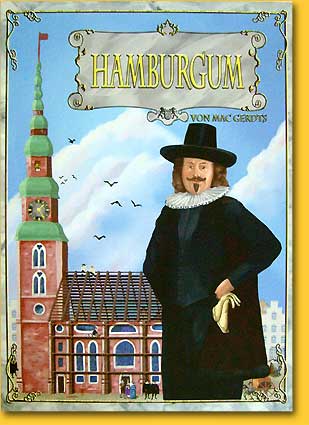 |
| In the seventeenth century, Hamburg was the biggest and most prosperous city of Germany. The players represent families of Hamburg that want to profit from this wealth. We trade sugar, beer and cloth, ship these goods with our own fleet and earn money to fulfil our ultimate goal: make donations to he church! Excuse me, make donations to the church? Not rather: gather riches, buy mansions and other items that suggest great wealth, exploit factories, dominate other countries and more of the sort? No, those were different times, and you could only earn prestige by donating to the church: marble, golden decorations, painted glass, huge chandeliers... If you’ve ever seen the interior of St. Peter’s Cathedral in Rom, you will get the picture. |
| x |
|
|
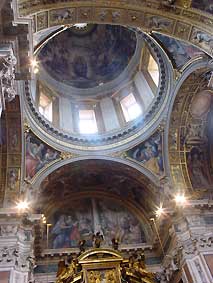 |
|
|
|
| The game board shows a map of Hamburg, divided into six districts and a harbour. In a player’s turn, he can carry out one of seven possible actions. The actions are selected on a rondel, similar to the one we know from Imperial. The players are allowed to move three spaces on the rondel for free, but in exchange for victory points, they can move additional steps. |
|
|
| x |
|
|
|
|
|
|
|
|
|
|
|
|
|
|
|
|
|
|
|
|
|
|
|
|
|
|
|
|
|
|
|
|
|
|
|
|
|
|
|
|
|
|
|
|
|
|
|
|
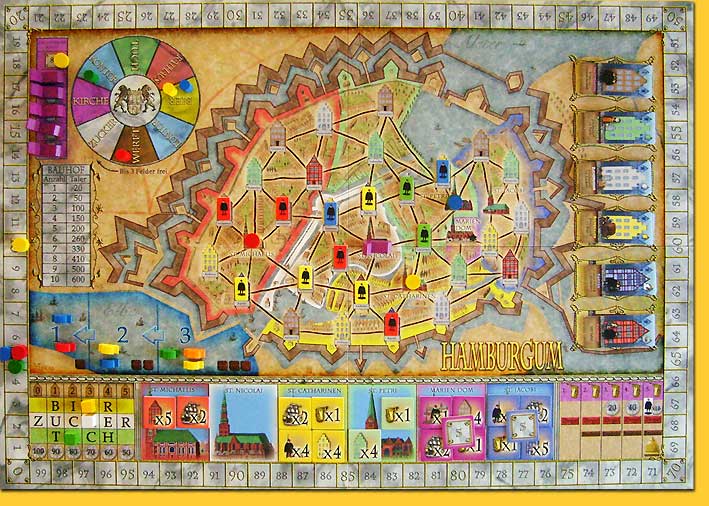 |
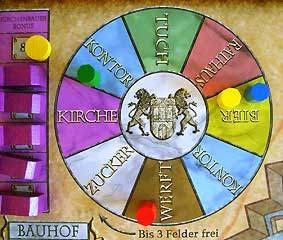 |
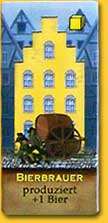 |
x |
When you choose the action ‘sugar’, ‘beer’ or ‘cloth’, you produce one cube of this good. For each production building of the same kind that you possess, you produce one additional cube. |
|
|
|
|
|
|
| xx |
|
|
|
|
|
|
|
|
|
|
|
|
|
|
|
|
|
|
|
|
|
|
|
|
|
|
|
|
|
|
|
|
|
|
|
|
|
|
|
|
|
|
|
|
|
|
|
|
| The action ‘trade’ allows the players to either ship their goods to collect income, or spend their money on resources. Each ship a player owns can transport one type of goods. The capacity of the ship is 1, 2 or 3 cubes, depending on the berth the ship is in. The value of the three different goods is 100 German Taler at the start of the game, but the law of supply and demand is followed accurately; for each production building that is constructed, the value of that good drops with 10 Taler. Instead of selling goods, players can buy any of the resources: timber, bricks and church bells. The prices increase if you buy more resources simultaneously: one resource costs 10 Taler, three random resources cost 100 Taler, and 10 resources 600 Taler! |
|
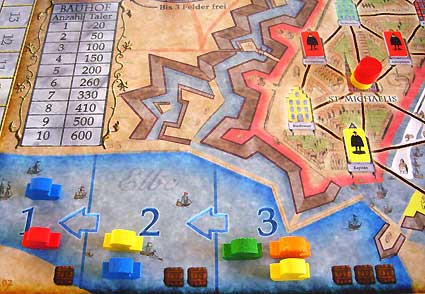 |
|
| xx |
|
|
|
|
|
|
|
|
|
|
|
|
|
|
|
|
|
|
|
|
|
|
|
|
|
|
|
|
|
|
|
|
|
|
|
|
|
|
|
|
|
|
|
|
|
|
|
|
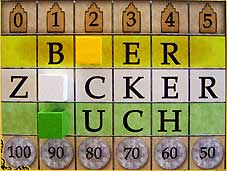 |
|
The action ‘dockyard’ can be used to build ships for 1 timber per ship. The new ships are placed in berth 3; when berth 3 is full, the ships are moved to berth 2, and the ships from berth 2 are shifted to berth 1, and the ships from berth 1 are returned to their owners. The capacity of a berth is equal to the number of players. |
|
|
| xx |
|
|
|
|
|
|
|
|
|
|
|
|
|
|
|
|
|
|
|
|
|
|
|
|
|
|
|
|
|
|
|
|
|
|
|
|
|
|
|
|
|
|
|
|
|
|
|
|
With the action ‘guildhall’, players can construct buildings. All buildings cost one timber and one brick. The player places the selected building in front of him, and he places a citizen in his colour on the board, on one of the miniature pictures of the building he just constructed. But: a citizen may only be placed on a construction site that is adjacent to a church where the player has already made a donation, or adjacent to one of his own buildings. Players that have made a fifth (last) donation to a church don’t have to worry about this restriction; they are allowed to build anywhere on the board.
There are production buildings for all three types of goods, that allow the players to produce one extra cube of this good. And there is a merchant that allows the player to take 100 Taler, and a captain that enables players to place one ship and one ‘Flying Dutchman’ (neutral ship) in the harbour. The councilman-buildings allow the player to take a certain amount of money from the bank, depending on several criteria, for example 10 Taler for every own citizen on the board. |
|
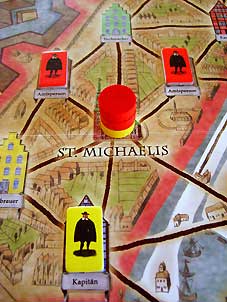 |
| xx |
|
|
|
|
|
|
|
|
|
|
|
|
|
|
|
|
|
|
|
|
|
|
|
|
|
|
|
|
|
|
|
|
|
|
|
|
|
|
|
|
|
|
|
|
|
|
|
|
|
|
| xx |
|
|
|
|
|
|
|
|
|
|
|
|
|
|
|
|
|
|
|
|
|
|
|
|
|
|
|
|
|
|
|
|
|
|
|
|
|
|
|
|
|
|
|
|
|
|
|
|
| But now for the most important action: donating to the church! In each of the six districts, there is one church that can be constructed by five donations. The donations have fixed costs, ranging from 1 brick for the first donation to 1 brick, 1 timber, 1 church bell and 10 Taler per own citizen on the board for the last donation. A player may make as many donations in his turn as he can afford, but only to one church. As a reward, he receives a donation token for every donation. These tokens can be used to score victory points, which is what the game is all about! |
|
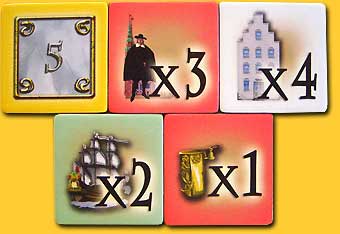 |
|
|
| xx |
|
|
|
|
|
|
|
|
|
|
|
|
|
|
|
|
|
|
|
|
|
|
|
|
|
|
|
|
|
|
|
|
|
|
|
|
|
|
|
|
|
|
|
|
|
|
|
|
 |
|
You can get points for the number of ships you have in the harbour, for buildings of a specific type, for citizens in a specific district, or for previously collected donation tokens. A player may keep his donation tokens until he has two tokens of the same kind, for instance, two tokens that give points for citizens in a certain district. He then has to score one of the tokens and place it face-down. The other token he can keep, so that it can be scored at a more convenient time, for example, when the player has more citizens in that specific district later in the game. |
|
|
| xx |
|
|
|
|
|
|
|
|
|
|
|
|
|
|
|
|
|
|
|
|
|
|
|
|
|
|
|
|
|
|
|
|
|
|
|
|
|
|
|
|
|
|
|
|
|
|
|
|
| The game ends when all six churches are completed. The un-scored donation tokens are scored, and the players receive some points for excess goods, money and resources. The player with the most victory points wins. |
|
|
| xx |
|
|
|
|
|
|
|
|
|
|
|
|
|
|
|
|
|
|
|
|
|
|
|
|
|
|
|
|
|
|
|
|
|
|
|
|
|
|
|
|
|
|
|
|
|
|
|
|
| xx |
|
|
|
|
|
|
|
|
|
|
|
|
|
|
|
|
|
|
|
|
|
|
|
|
|
|
|
|
|
|
|
|
|
|
|
|
|
|
|
|
|
|
|
|
|
|
|
|
| xx |
|
|
|
|
|
|
|
|
|
|
|
|
|
|
|
|
|
|
|
|
|
|
|
|
|
|
|
|
|
|
|
|
|
|
|
|
|
|
|
|
|
|
|
|
|
|
|
|
 |
|
|
|
|
|
|
|
|
|
|
|
|
|
|
|
|
|
|
|
|
|
|
|
|
|
|
|
|
|
|
|
|
|
|
|
|
|
|
|
|
|
|
|
|
| The first thing you notice when playing 'Hamburgum' is that you can soon switch on your autopilot. Produce goods, sell goods, buy building materials, donate building materials to church, produce new goods et cetera. Only now and then you will make an extra stop to build a ship or construct a building. The game goes extremely fast at this stage, and it feels a bit mechanical, as if you don’t have to make any decisions because there is only one logical option that you can carry out at high speed without thinking. |
|
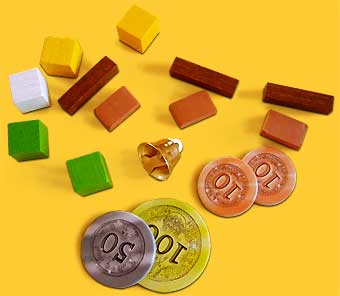 |
|
|
| xx |
|
|
|
|
|
|
|
|
|
|
|
|
|
|
|
|
|
|
|
|
|
|
|
|
|
|
|
|
|
|
|
|
|
|
|
|
|
|
|
|
|
|
|
|
|
|
|
|
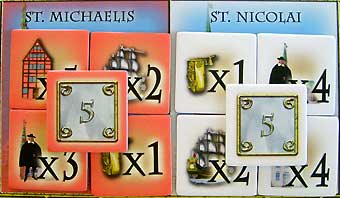 |
|
The first player to make a donation to a church automatically receives the donation token of five points. With the other four donations, the players may choose a donation token from the remaining four. These four tokens almost always yield more than five points, which makes it unfavourable to make that first donation. The differences in the costs between the first and subsequent donations are too small to compensate for this. The other four donation tokens are comparable to each other with respect to the number of points that can be scored. It happens only seldom that one token is so favourable for one player that the other players feel morally obliged to take this token before he gets the chance. It sounds more strategic than it really is. |
|
|
| xx |
|
|
|
|
|
|
|
|
|
|
|
|
|
|
|
|
|
|
|
|
|
|
|
|
|
|
|
|
|
|
|
|
|
|
|
|
|
|
|
|
|
|
|
|
|
|
|
|
| The same holds true for the buildings: quick, build the last sugar production building before John can do it! Ah well, then John just takes a bier production building, whatever. It doesn’t really matter all that much. And how about placing citizens on the board: because of the building restriction (only adjacent to a church you have made a donation to, or to another own citizen) it seems like you can block each other from certain areas of the board by placing your own citizens strategically, but in practice the grid on the board has such a high degree of branching that you can go in so many directions, and you’ll always find an available space for your desired building. |
|
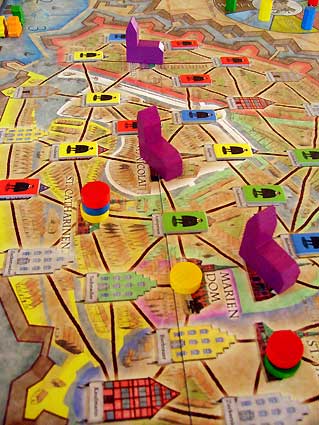 |
|
|
| xx |
|
|
|
|
|
|
|
|
|
|
|
|
|
|
|
|
|
|
|
|
|
|
|
|
|
|
|
|
|
|
|
|
|
|
|
|
|
|
|
|
|
|
|
|
|
|
|
|
 |
The game components are of high quality; all the important information can be found on the board, or on the very clear and complete rule summary cards. The little bricks, ships and real church bells also add to the atmosphere of the game. However, the lines that separate the six districts on the board are too subtle, and because of the chaotic illustrations on the board they are quite hard to distinguish. |
|
|
|
|
|
|
|
| xx |
|
|
|
|
|
|
|
|
|
|
|
|
|
|
|
|
|
|
|
|
|
|
|
|
|
|
|
|
|
|
|
|
|
|
|
|
|
|
|
|
|
|
|
|
|
|
|
|
‘Hamburgum’ is not as much a strategic game as it pretends to be; most of the time you get the feeling that it doesn’t really matter what you do, what building you construct, where you place it, what donation token you choose et cetera. It doesn’t have enough depth to justify the two hours that it takes to play the game. On the positive side, the rondel works very well, and the game plays like an oiled machine; the two hours you spend on it are certainly two pleasant hours.
© 2008 Barbara van Vugt
Hamburgum, Mac Gerdts, Eggertspiele / Hutter Trade, 2008 - 2 to 5 players, 12 years and up, 75 to 90 minutes
|
|
|
|
|
|
|
|
  |
|
|
|
|
|
|
|
|
|
|
|
|
|
|
|
|
|
|
|
|
|
|
|
|
|
|
|
|
|
|
|
|
|
|
|
|
|
|
|
|
|
|
|
|
  |
Brick wood brick wood money bell church |
  |
|
|
|
|
|
|
|
|
|
|
|
|
|
|
|
|
|
|
|
|
|
|
|
|
|
|
|
|
|
|
|
|
|
|
|
|
|
|
|
|
|
|
|
|
  |
|
|
|
|
|
|
|
|
|
|
|
|
|
|
|
|
|
|
|
|
|
|
|
|
|
|
|
|
|
|
|
|
|
|
|
|
|
|
|
|
|
|
|
|
  |
Including a half point deduction for the graphics |
| x |
|
|
|
|
|
|
|
|
|
|
|
|
|
|
|
|
|
|
|
|
|
|
|
|
|
|
|
|
|
|
|
|
|
|
|
|
|
|
|
|
|
|
|
|
|
|
|
|
| x |
|
|
|
|
|
|
|
|
|
|
|
|
|
|
|
|
|
|
|
|
|
|
|
|
|
|
|
|
|
|
|
|
|
|
|
|
|
|
|
|
|
|
|
|
|
|
|
|
 |
|
|
|
|
|
|
|
|
|
|
|
|
|
|
|
|
|
|
|
|
|
|
|
|
|
|
|
|
|
|
|
|
|
|
|
|
|
|
|
|
|
|
|
|
 |
|
|
|
|
|
|
|
|
|
|
|
|
|
|
|
|
|
|
|
|
|
|
|
|
|
|
|
|
|
|
|
|
|
|
|
|
|
|
|
|
|
|
|
|
| x |
|
|
|
|
|
|
|
|
|
|
|
|
|
|
|
|
|
|
|
|
|
|
|
|
|
|
|
|
|
|
|
|
|
|
|
|
|
|
|
|
|
|
|
|
|
|
|
|
 |
|
|
|
|
|
|
|
|
|
|
|
|
|
|
|
|
|
|
|
|
|
|
|
|
|
|
|
|
|
|
|
|
|
|
|
|
 |
|
|
|
|
|
|
|
|
|
|
|
|
|
|
|
|
|
|
|
|
|
|
|
|
|
|
|
|
|
|
|
|
|
|
|
|
|
|